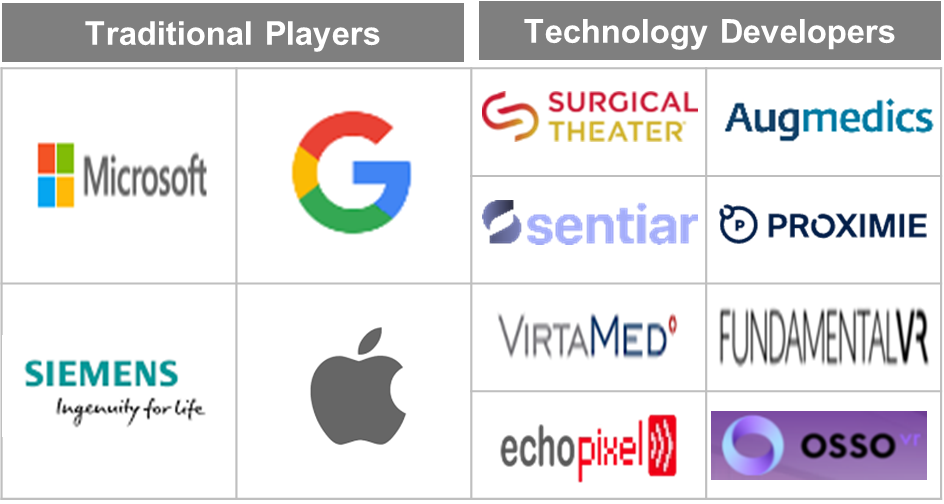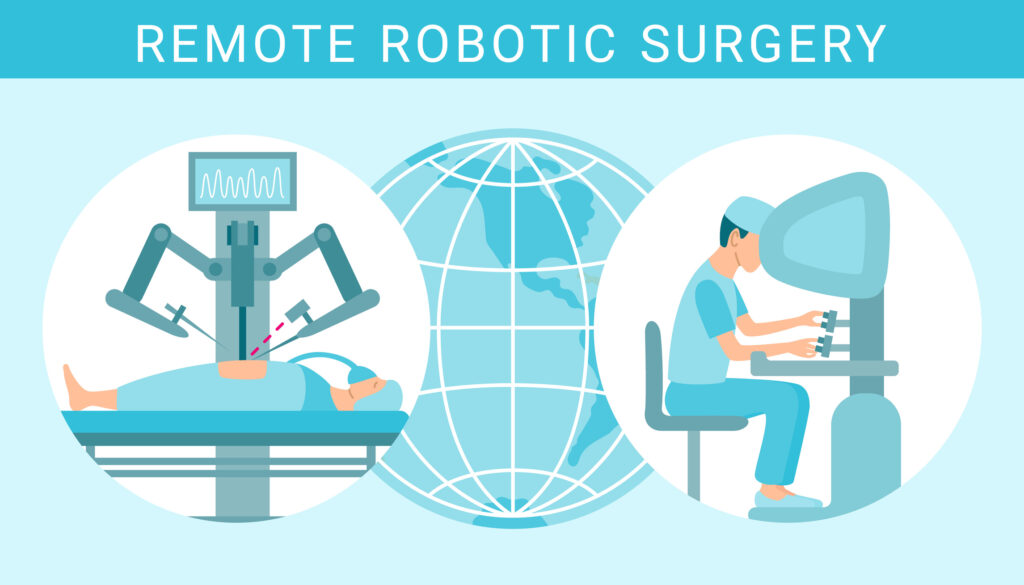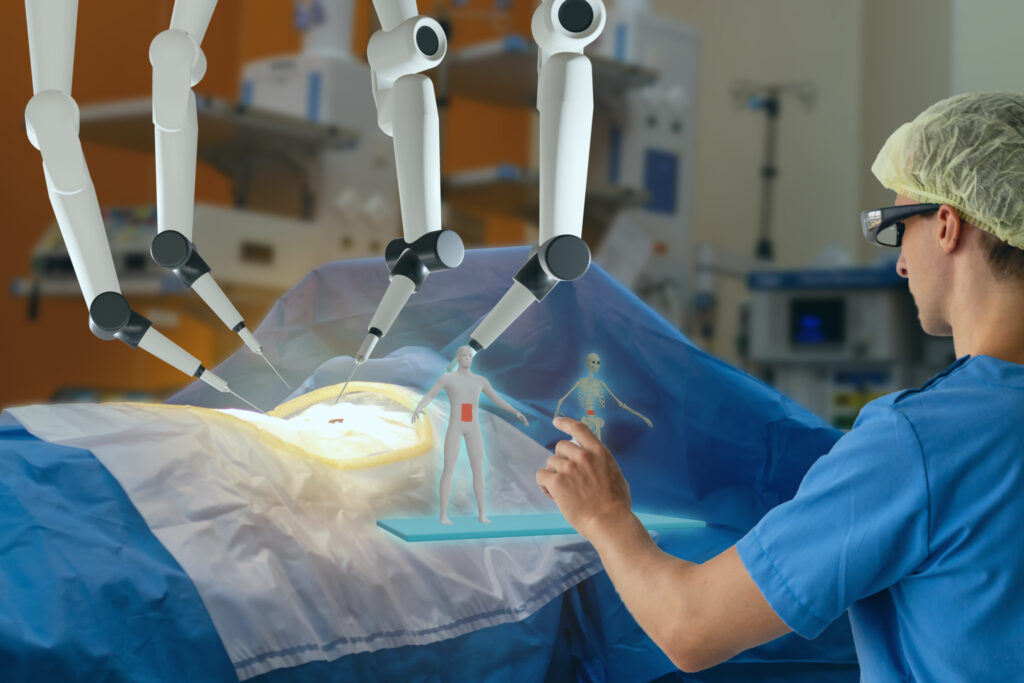The evolving technological scene in the digital surgical workspace has led to the emergence of several state-of-the-art innovations in the medical sector. Augmented reality (AR) and virtual reality (VR) are rapidly becoming available, accessible and, affordable. The future of surgery is virtual, mixed and, augmented; and offers many improvements and cost reductions for medical training. Recent progress within the space guarantees to accelerate the learning curve for surgical innovations.
AR/VR Assisted Surgeries
Augmented and virtual reality in surgery (AR/VR surgery) has become a ground-breaking development in the medical field, revolutionizing training methods and robotic surgical techniques. Virtual surgery offers a revolutionary method by combining the advantages of realistic simulations, improved visualization, and real-time assistance. It does this by leveraging the capabilities of virtual reality and augmented reality technology. With this innovative technique, doctors may plan surgeries, practice intricate procedures, and hone their abilities in a virtual setting that resembles actual operating rooms. Virtual surgery gives physicians a risk-free and engaging platform on which to improve patient outcomes, surgical performance overall, and technique. Virtual surgery is positioned to influence the future of surgical practice by potentially revolutionizing preoperative planning, intraoperative guiding, and surgical training.
Augmented Reality is a computer-based technology that merges the digital world with the real world and upgrades the interaction between digital elements and real-world surroundings. Virtual Reality uses software and headset devices to replace a person’s view from the real world with a digitally created scene. Mixed or Hybrid Reality (MR) combines AR and VR. AR/VR surgical planning and training tools have been adopted by several surgical domains and applications, such as:
- VR surgery training simulators: Ocular surgery, plastic surgery, orthopedic surgery, etc.
- AR assistance in surgery: Otolaryngology, cardiovascular surgery, thoracic surgery, general surgery, etc.
- Mixed Reality (combination of VR training simulators & AR assistance in surgery): Laparoscopy, liver surgery, neurosurgery, spine surgery, maxillofacial surgery, breast surgery, orthopedic surgery, etc.
AR & VR Market
Interestingly, the AR & VR market is slated to grow at a CAGR of 10.77% between 2024-2028 and is projected to generate USD 38.6 billion in revenue during 2024. And given the growth, the volume may reach USD 58.1 billion by 2028.
AR/VR for Enhanced Surgical Experience
The COVID-19 pandemic has changed the education and training scenario across the world. In the healthcare domain, AR/VR has specifically used new technologies essential for continuing the education and training of medical professionals. The development of AR/VR devices has enhanced the standard of medical training. These devices allow surgeons to experience real-life situations through simulated scenarios, making it easier to gain practical knowledge.
The use of VR for training surgical professionals has helped significantly reduce the cost and time of training sessions. AR/VR training suites allow surgeons to train for longer durations and improve accuracy repeatedly. They also make it easier to assess a surgeon’s progress on a new procedure and identify areas for improvement.
Surgeons, radiologists, and other healthcare professionals employ various technologies to optimize patient outcomes. Digital Reality includes a vast spectrum of technologies like AR, VR, and MR that simulate real-life experiences.
AR and VR technologies help medical professionals better appreciate structures in real or virtual space, making the transition from learning to clinical environments easier. AR/VR-assisted surgeries combine the acquired 3D images of the anatomy of interest with surgical reference points.
Multiple studies have illustrated the use of AR/VR technology to guide surgeons during different types of minimally invasive surgeries with improved accuracy, less radiation exposure, blood loss, and fewer complications.
Virtual Reality in Surgery: Market Trends & Major Competitors
Healthcare professionals are applying AR and VR to enhance patient treatment facilities. Through AR and VR treatment, experts can effortlessly identify, detect, train, and cure health problems. Due to the COVID-19 pandemic, medical service providers are looking for virtual and augmented reality tools to nurture the connection with patients and provide good personalized care with limited physical contact. Therefore, many companies are actively investing in the domain.

Some of the market players working particularly to improve the applications of AR/VR in surgical interventions are presented below:
- Surgical Theater – The Company developed a “surgical rehearsal platform” for neurosurgical procedures called Precision VR. It allows for better preoperative planning.
- Augmedics – The company is the first to develop an augmented reality guidance system for surgery called xvision. The technology adds a 3D representation that enables surgeons to see the patient’s anatomy through skin and tissue through X-ray vision.
- SentiAR – The company offers holographic, Augmented Reality (AR) technology that provides physicians with a single source of information during interventional procedures – giving them a real-time, interactive, 360-degree view of the treatment.
- VirtaMed – The company is the world leader in data-driven medical education through data-driven simulation for training outside the operating room.
- FundamentalVR – It offers flight simulator-like training for surgeons. The technology allows surgeons to practice and improve their surgical techniques in a controlled environment that includes haptic elements for tactile feedback. The company also offers AR tech using Microsoft’s HoloLens technology. It allows users to work together through the simulations.
- EchoPixel – It offers True3D, an AR healthcare platform that facilitates visualizing the organs and tissue of a specific patient. Users can also see holograph-like images provided by the technology.
- OSSO VR – Specializes in virtual reality that facilitates surgical training and assessments. It offers fully immersive VR experiences, complete with haptic feedback.

AR/VR Surgery: Training Students for Surgeries
Another element of medical education focuses on the physical aspect, which includes tasks like catheter insertion, blood drawing, and surgical procedures. In contrast to traditional methods that involve studying textbooks, slide shows, and observing professionals, AR and VR technologies enable students to acquire these practical skills by actively engaging in them in a virtual or mixed-reality setting. By practicing these skills in an immersive environment, medical students not only enhance the effectiveness of their learning but also develop a greater level of accuracy and precision.
AR and VR technologies offer benefits not only to medical professionals but also to patients. They help patients better understand medical conditions, treatment options, and various procedures.
AR/VR Surgery: Recent Technology Trends
Despite being in the early stages, AR/VR has drastically altered the possibilities and revolutionized surgical procedures. Many passionate people are working tirelessly to perfect these technologies to expand their scope in healthcare. It is specifically in the surgical domain. Some of the recent technological developments using AR/VR in surgical assistance are as follows:
- Machine learning combined with AR creates ultra-precise 3D medical images for use during surgical procedures. It also allows the real-time sharing of surgical data and helps surgeons collaborate with colleagues on surgery plans.
- Combination of virtual reality and a surgical robot to perform minimally invasive procedures.
- Realistic hand-based interactions through a virtual surgical simulation platform allow surgeons to practice with virtual tools, improving their training experience and sharpening their skills.
- AR tools help create personalized 3D models by scanning the patient’s body, identifying the disease, and creating a step-by-step surgical plan.
- The AR guidance system creates a 3D representation of the patient’s anatomy and lets surgeons see-through skin and tissue, like an x-ray image while performing the surgical procedure.
- An interactive virtual surgical platform allows doctors to visualize the anatomy of interest and precisely improve the quality of medical images in real-time.
- Haptic-based VR simulations provide a more tactile experience training simulation and allow medical professionals to navigate through a simulated 3D space with an environment similar to a real-world medical procedure.
- HoloLens Mixed Reality headset is a new generation AR & VR technology and software platform that provides a stereoscopic 3D real-time vision, which has helped doctors reduce surgery time by 50%.
Virtual Reality in Surgery: What Future Holds for AR/VR in Surgeries?
The advancement of technology is reshaping everything around us, including the healthcare field. Access to 3D information via AR/VR technology can greatly help during complex surgical procedures. AR/VR is revolutionizing surgical training, surgery planning, and the efficiency of health systems, ultimately improving patient health outcomes.
The future of AR/VR-assisted surgeries holds potential for the scope of improvement in the following aspects:

- Development in hardware & software – Newly developed hardware and software have decreased costs.
- Communication technology – 5G mobile network technology incorporated in AR/VR-based systems will accelerate its adoption by huge masses.
- Easy visualization – AR helps surgeons see the inside of targeted body parts. The CEO and President of SentiAR quoted – “In the future, entire procedures will be digitized, and doctors will be able to communicate with the instruments that surround them through voice, gesture, and gaze.”
- Remote-guided surgeries – AR/VR helps surgeons operate remotely and in real-time. Additionally, it allows them to collaborate with colleagues to plan surgery and select the accurate procedure method.

- Minimally invasive surgeries – AR/VR provides direct visualization of the patient’s anatomy in a three-dimensional format. Also, it helps improve the surgeon’s view and perform minimally invasive surgery more accurately and precisely.
- AR/VR & Robotics – As per a review by the Bio-Medico University of Rome, the combination of robotics and AR/VR technology shows distinct advantages, such as accuracy improvement, hospital stay, and rate of complications in spinal surgeries. Similarly, other surgical areas are open for exploration.
- Mixed-Reality – The combined elements of AR & VR allow surgeons to perform surgery on patients that are halfway across the world. It also offers better communication and collaboration among medical professionals and efficient surgical planning, enabling faster and better care at lower costs.